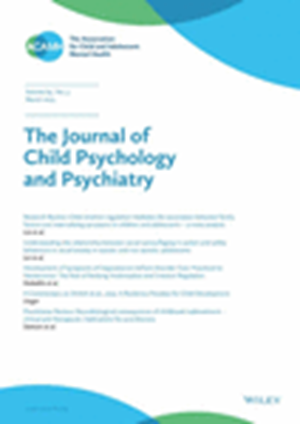Emotional and behavioural difficulties in gender minority compared to cisgender adolescents: identity specific findings from a contemporary national study.
IF 7
1区 医学
Q1 PSYCHIATRY
引用次数: 0
Abstract
BACKGROUND Gender minority adolescents are more likely to report emotional and behavioural difficulties compared to their cisgender peers. However, little is known about these experiences for adolescents with specific gender minority identities. METHODS Cross-sectional data were obtained from the 2021/22 Student Health and Well-being survey, a national survey of 11-16-year-olds in Wales, UK. Emotional and behavioural difficulties were measured using the Strengths and Difficulties Questionnaire. Gender identity and assigned sex at birth were self-reported. Multivariable linear regressions with robust standard errors were used to examine associations between gender identity and emotional and behavioural difficulties, adjusting for age, ethnicity, household-level affluence and correction for multiple testing. RESULTS Of the 122,766 participants, 2.0% (2,455) identified as a person with a gender minority identity. Twenty-eight gender minority identities were self-reported, with the most prevalent being transgender boy and nonbinary assigned female at birth (both 0.6%). Young people assigned female at birth comprised 80% of gender minority adolescents. In the adjusted model, emotional and behavioural difficulties were reported most frequently by people who identified as non-binary (B = 7.66, 95% CI 7.25, 8.06) and another gender identity (B = 7.86, 95% CI 7.34, 8.38), then transgender (B = 5.05, 95% CI 4.58, 5.51), when compared to cisgender adolescents. Female sex assigned at birth was associated with more reported difficulties than male sex assigned at birth for adolescents with a transgender or cisgender identity, but not a nonbinary identity. CONCLUSIONS In this population-based study, emotional and behavioural difficulties were reported most frequently by adolescents who identified as nonbinary and another gender identity, then transgender, then cisgender. Health and educational practitioners need to be aware that emotional and behavioural difficulties differ across gender minority identities.与顺性青少年相比,性别少数群体的情感和行为困难:来自当代国家研究的身份特异性发现。
背景:与顺性别同龄人相比,少数性别青少年更有可能报告情感和行为上的困难。然而,对于具有特定性别少数认同的青少年的这些经历,我们知之甚少。方法横断面数据来自2021/22学生健康与幸福调查,这是一项针对英国威尔士11-16岁学生的全国性调查。使用优势和困难问卷测量情绪和行为困难。出生时的性别认同和生理性别都是自我报告的。使用具有稳健标准误差的多变量线性回归来检查性别认同与情感和行为困难之间的关联,调整年龄、种族、家庭富裕程度,并对多重测试进行校正。结果在122,766名参与者中,2.0%(2,455人)认为自己是性别少数群体。28个性别少数认同是自我报告的,最普遍的是变性男孩和出生时非二元性别分配的女性(均为0.6%)。出生时被指定为女性的青少年占性别少数群体青少年的80%。在调整后的模型中,与顺性青少年相比,被认定为非二元(B = 7.66, 95% CI 7.25, 8.06)和另一性别认同(B = 7.86, 95% CI 7.34, 8.38)的人最常报告情绪和行为困难,然后是跨性别(B = 5.05, 95% CI 4.58, 5.51)。对于具有跨性别或顺性别认同的青少年来说,出生时性别分配的女性比出生时性别分配的男性有更多的困难,而非二元认同的青少年则没有。结论:在这项以人群为基础的研究中,情绪和行为困难最常见于非二元性和其他性别认同的青少年,其次是跨性别者,然后是顺性别者。保健和教育从业人员需要认识到,情感和行为困难因性别少数群体身份而异。
本文章由计算机程序翻译,如有差异,请以英文原文为准。
求助全文
约1分钟内获得全文
求助全文
来源期刊
CiteScore
13.80
自引率
5.30%
发文量
169
审稿时长
1 months
期刊介绍:
The Journal of Child Psychology and Psychiatry (JCPP) is a highly regarded international publication that focuses on the fields of child and adolescent psychology and psychiatry. It is recognized for publishing top-tier, clinically relevant research across various disciplines related to these areas. JCPP has a broad global readership and covers a diverse range of topics, including:
Epidemiology: Studies on the prevalence and distribution of mental health issues in children and adolescents.
Diagnosis: Research on the identification and classification of childhood disorders.
Treatments: Psychotherapeutic and psychopharmacological interventions for child and adolescent mental health.
Behavior and Cognition: Studies on the behavioral and cognitive aspects of childhood disorders.
Neuroscience and Neurobiology: Research on the neural and biological underpinnings of child mental health.
Genetics: Genetic factors contributing to the development of childhood disorders.
JCPP serves as a platform for integrating empirical research, clinical studies, and high-quality reviews from diverse perspectives, theoretical viewpoints, and disciplines. This interdisciplinary approach is a key feature of the journal, as it fosters a comprehensive understanding of child and adolescent mental health.
The Journal of Child Psychology and Psychiatry is published 12 times a year and is affiliated with the Association for Child and Adolescent Mental Health (ACAMH), which supports the journal's mission to advance knowledge and practice in the field of child and adolescent mental health.

 求助内容:
求助内容: 应助结果提醒方式:
应助结果提醒方式:


